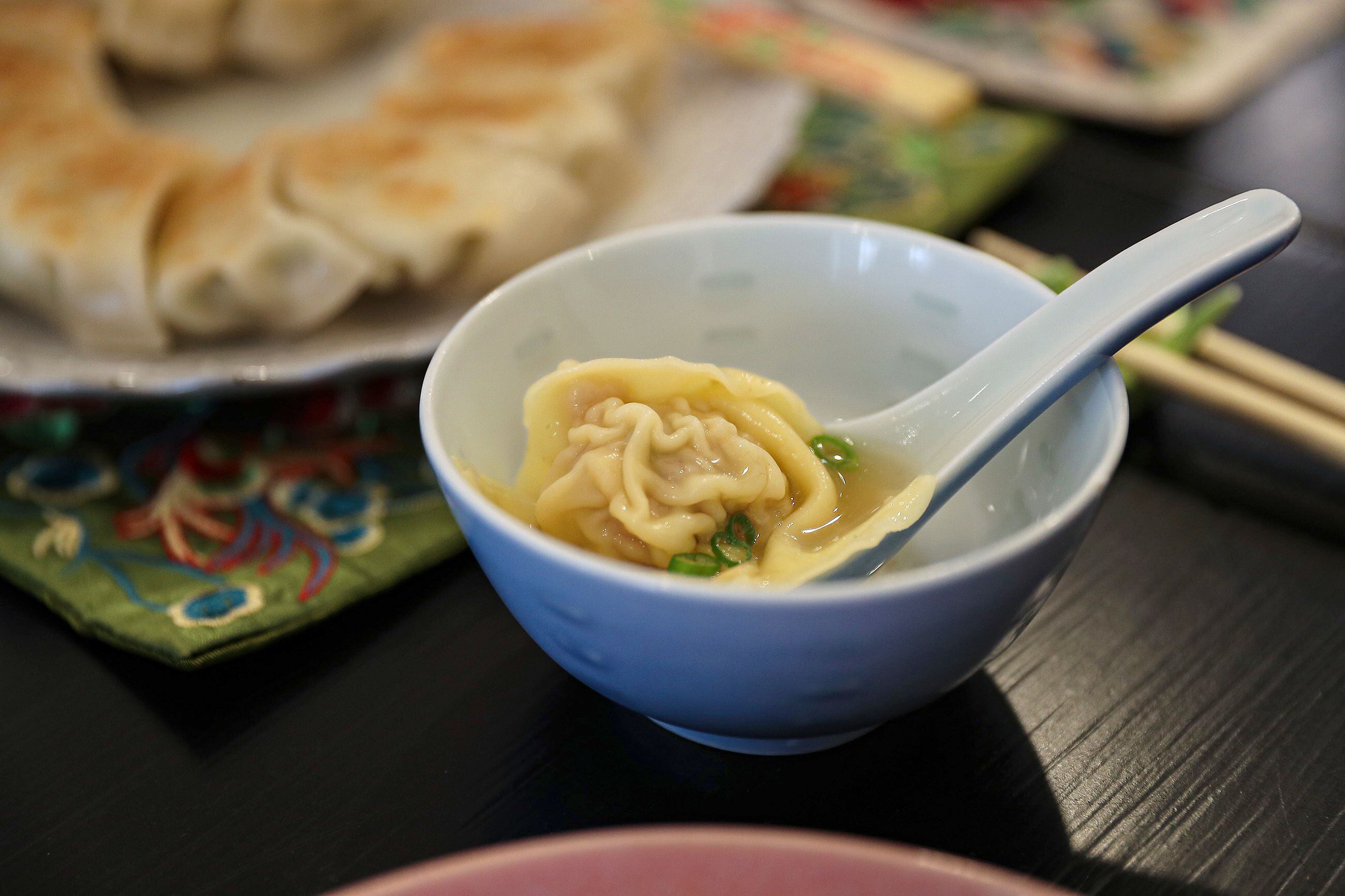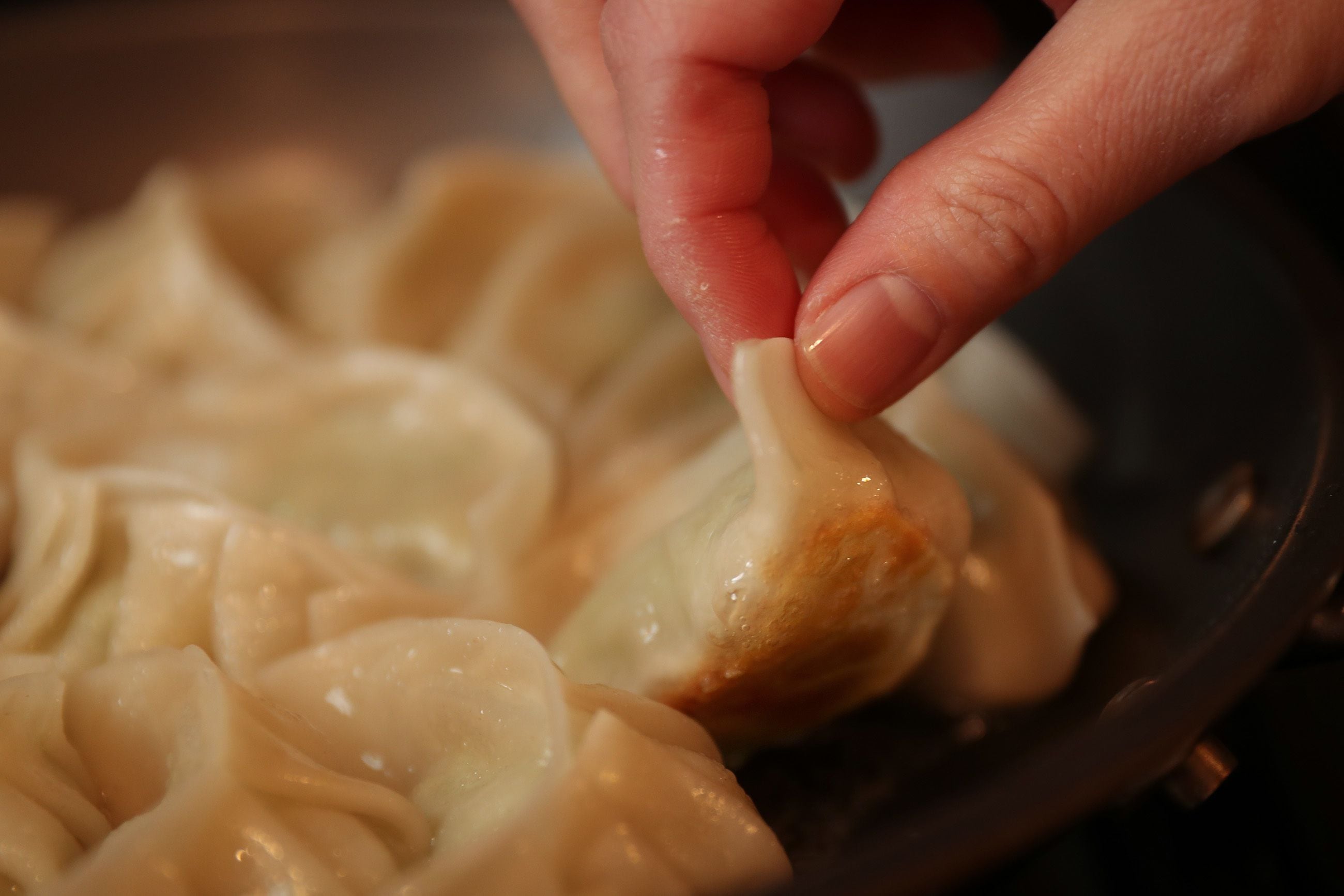On Chinese New Year, dumplings take two Philly chefs back home
Chinese New Year falls on a single day, but for those who celebrate, it is anticipated as a season.

Kiki Aranita is the co-chef/owner of Poi Dog in Center City.
Chinese New Year falls on a single day, but it is anticipated and prepared for as a season. Life becomes imbued with symbols: red to signify luck, dumplings that mimic gold ingots, fish to signify abundance. It is when people journey home to see their families.
My hometown, Hong Kong, transforms: Christmas trees and fiberglass Santas are replaced by strands of firecrackers and, thanks to this year’s zodiac, cute ornamental rats decked out in gold costumes. Homes are swept, intricate dinners are arranged, and plans are made to visit relatives. It’s the only time this fast-paced, consumer-driven city takes a break, closes up shop, and focuses on family.
I have now lived in the U.S. longer than I did in Hong Kong. During college and graduate school in New York and Philly, I celebrated Lunar New Year with other expat kids of Chinese descent, all of us displaced for different reasons. We gathered in our dorms or living rooms, cobbling together dishes from Hong Kong, Taiwan, Singapore, and other countries. Our cultural and culinary traditions would merge on one table: long noodles slick with peanut sauce, sticky-sweet rice cake called nian gao, and crispy spring rolls fried on a rickety dorm room stove.
My favorite New Year’s tradition, though, is making dumplings. It’s something I share with my fellow Philadelphian and Taiwanese American friend Judy Ni, who owns and operates Baology in Center City.
Judy and I get together to make dumplings at my house, which fills with the fragrance of garlic, sesame oil, and soy sauce. We make two kinds, my pork-and-water chestnut wontons and her chicken-and-garlic chive potstickers, comparing recipes and contrasting our upbringings as we go.
I tell Judy that while I exercise restraint in seasoning — letting the eater add seasonings at the end — I rarely measure out exact quantities in my family’s wonton recipe. (Somehow, it tastes the same every time I make it.) She raises an eyebrow. Her recipe is far more precise.
She pinches together potstickers as she talks, pausing only to pick up chopsticks to add as much of the chicken and garlic chive filling as she can to each wrapper. “My mother always said I was the best at folding or ‘bao’-ing potstickers since I could fit the most filling into each dumpling.”
Her potstickers look like plump little presents. Her fingers pleat so swiftly and nimbly that before I know it, Judy has arranged dozens of them into a pretty circular pattern on the plate. She sears, then flash-steams them with a splash of water in the pan.
I pull out the big bowls of ground pork and water chestnuts I prepared the night before and place them on the table. In contrast to Judy’s potstickers, I like my dumplings tiny. I set up eight wonton wrappers on the counter at once, spooning barely a teaspoon of filling into the center of each, wetting all the edges, then rapidly folding them in batches.
I freeze them before cooking to help them hold their shape. When I simmer them in chicken broth, my dog runs around in circles, riled up by the aroma.
Our conversation inevitably turns to our home countries. Judy tells me she is invigorated by the reelection of Taiwan President Tsai Ing-wen. I tell her about my upcoming New Year’s Day trip to Hong Kong. I share my concern that while the season carries the same sense of auspiciousness, this year’s celebrations will be freighted with caution: On recent visits, I’ve checked updates on protests as frequently as the weather. But even though the tensions are palpable, they would not prevent me from returning to Hong Kong.
In Philadelphia, my home of eight years, making and sharing New Year’s dumplings with friends temporarily takes the sting out of homesickness. And there is something extraordinary about opening up a family holiday to friends. In the process, Judy has become like family to me. She makes herself at home in my kitchen. She knows exactly where I keep the utensils, oil, soy sauce, and plates.
I pull out tiny porcelain dishes from my cabinets for her soy-chili dipping sauces, eagerly awaiting the potstickers she slides out from the pan. I ladle broth and slippery wontons into bowls, dousing mine with sesame oil and soy sauce. I raise my bowl to my lips and impatiently blow and sip at the hot broth.
As we dive into our dumplings, I ask Judy what her favorite part of the New Year as a child was.
Without hesitation, she says, “Receiving hong bao,” the Mandarin equivalent of lai see, Cantonese for “lucky money” — a cash-filled envelope that children and unmarried ones receive on the day of the new year. The crisp new bills, in auspicious denominations of 100 or 500, are given to the unmarried after they recite well-wishes to the elders and married couples in their family.
“I used to sneak into the bathroom with all my lai see packets to tally up how much I got,” I confess.
Judy looks at me enviously, “We never got to keep ours. My mother collected them for our ‘education.’”
I ask Judy, “Did you also get yelled at as a child if you forgot to pour tea for your elders at dinner?”
She looks at me askance and says, “I still get yelled at now if I forget to pour them tea.”
Pork and Water Chestnut Wontons
Since eaters may dip their wontons in soy sauce, sesame oil, and chili oil, be careful not to overseason the filling or use salted chicken broth. Serves 4-6.
1 pound ground pork
1 cup chopped water chestnuts
1½ tablespoons white sugar
¼ cup soy sauce
2 tablespoons roasted sesame oil
2 teaspoons finely minced ginger
2 to 3 garlic cloves, minced
Pinch of salt
1 pack yellow egg wonton wrappers
1 cup cornstarch
1 quart chicken stock, preferably homemade and unsalted or low-sodium
Make the filling: In a large mixing bowl, combine all the filling ingredients (from the pork through the pinch of salt), then mix thoroughly with your hands. Be careful not to overmix. Cover the bowl, refrigerate, and marinate at least 2 hours and up to overnight.
Prepare for wrapping: Whisk 1 tablespoon of cornstarch with 1½ cups water to make a slurry. Set the slurry on a large cutting board or a clean table top. Place the wonton wrappers and the filling nearby.
Fill the wontons: Place about a teaspoon of filling in the center of each wonton wrapper. Dip a finger into the slurry, then trace half the edges of the wrapper. Fold the wrapper in half, forming a rectangle, and gently press the filling to eliminate air pockets. Twist the folded edges together so that the left bottom corner meets the right bottom corner. Gently pinch the joined corners together.
Lightly dust the bottom of each wonton in cornstarch before placing them on a plate; this prevents them from sticking. Cover the wontons and freeze for at least 15 minutes and up to 2 months.
Cook the dumplings: In a medium pot, bring the chicken stock to a rolling boil. Add the frozen wontons and cook for 4 to 5 minutes, or until the centers of the dumplings start to wrinkle.
Remove the pot from heat. Transfer the wontons and a bit of broth to a bowl. Garnish with sliced scallions and serve with soy sauce, sesame, and chili oil.
— Kiki Aranita of Poi Dog
Chicken and Garlic Chives Potstickers
This recipe calls for grinding chicken, but if you don’t have one, you can use a knife; use a combination of two-thirds white meat such as breasts or tenderloin and one-third dark meat such as thighs. Garlic chives look like onion chives but are garlicky and more fragrant; they’re widely available in area Asian markets. Kadoya brand sesame oil is a quality choice, as is Kong Yen rice vinegar; both are commonly found in Asian markets and online. Homemade or low-sodium chicken stock is preferred. A pack of Twin Marquis Shanghai dumpling wrappers will be enough for this recipe. Makes about 40 potstickers.
2½ pounds chicken
½ cup garlic chives
2½ tablespoons sesame oil
1½ tablespoons cornstarch
1 tablespoon rice vinegar
1 tablespoon kosher salt
2 teaspoons white pepper
2½ tablespoons grated ginger
1 tablespoon grated garlic
½ cup chicken stock
40 dumpling wrappers
Vegetable or canola oil
Make the filling: Use a meat grinder to process the chicken and garlic chives together. If you don’t have a meat grinder, finely chop them together with a knife.
In a large bowl, whisk together the sesame oil, cornstarch, rice vinegar, kosher salt, and white pepper until well combined. Add the ginger and garlic and mix well.
Place the ground chicken and chive mixture in the bowl of a standing mixer fitted with the paddle attachment. Mix on medium-low until the chicken and chive mixture forms a cohesive paste. Gradually add the chicken stock. Mix until thoroughly incorporated. Gradually add the sesame-cornstarch mixture and continue mixing until completely incorporated.
Bao (or wrap) the potstickers: Set the dumpling wrappers and a small bowl of water by a clean work surface. Lay one wrapper flat on the surface. Fill with 1 tablespoon filling. Dip a finger into the water and trace the border of the wrapper. Fold the edges of the wrapper together from opposite ends, leaving the middle unsealed.
Pleat the pot sticker: Hold the wrapper in one hand. With the forefinger and thumb of your other hand, pinch pleats into one side of the dumpling by pulling on the edge of the unsealed wrapper. Make about 6 pleats, 3 on the left and 3 on the right. Make sure to seal the pleats tightly.
Place a large nonstick skillet over medium heat. When the pan is warm, lightly coat the surface with a few tablespoons of oil, allowing it to heat for a minute.
Place the dumplings in the pan, making sure the bottoms are generously coated in oil to minimize sticking. Cook the dumplings until the bottoms just begin to brown.
Add just enough water to the pan to create a shallow layer of water in the bottom (don’t be afraid to pour it over the dumplings), then cover the pan tightly. Steam for 5 to 8 minutes, then lift the lid to check how much water has been absorbed. If there is still a significant amount left, cover the pan, leaving the lid slightly ajar so the remaining water can evaporate.
After the water evaporates, check the bottom of the potstickers. Once they reach the desired level of brownness, remove them from the pan and transfer to a plate, displaying the crispy bottoms. Serve with a dipping sauce of chili, garlic, sesame oil, and soy sauce.
— Judy Ni of Baology

